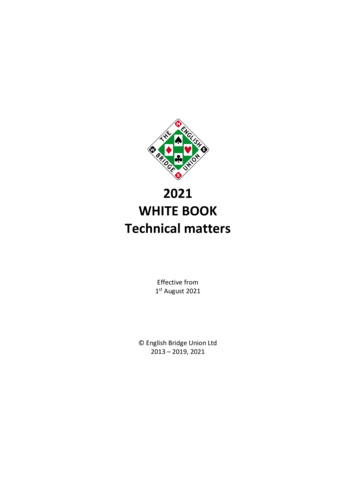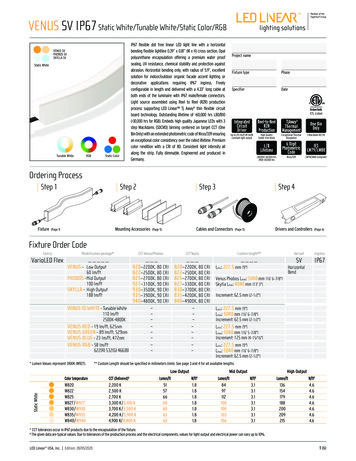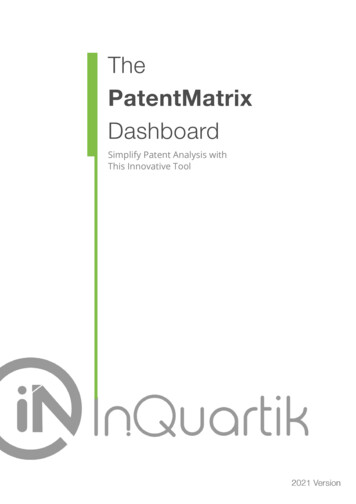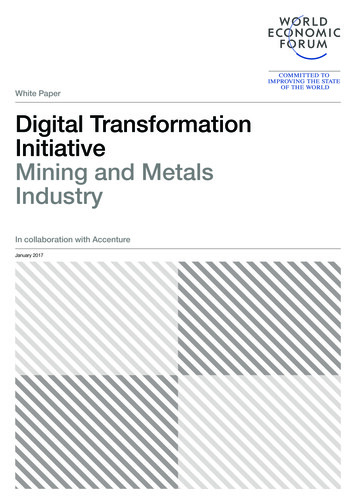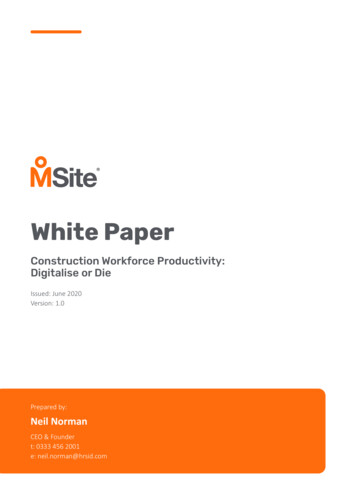
Transcription
White PaperConstruction Workforce Productivity:Digitalise or DieIssued: June 2020Version: 1.0Prepared by:Neil NormanCEO & Foundert: 0333 456 2001e: neil.norman@hrsid.com
2Construction Workforce Management: Digitalise or DieExecutive SummaryWith industry indicators pointing towards some tough times ahead for construction, it goes withoutsaying that the companies with higher productivity levels will be well-placed to survive the storm.This paper explains why, for many, it will be a case of Digitalise or Die.Productivity gains amongst the construction workforce have been virtually non-existent for the past 20years, yet through new and emerging technology the status quo may finally be about to change.With COVID-19 acting as a catalyst for rapid digitalisation in the management of construction workersand processes, the opportunity to improve productivity is ripe for the taking.This paper explores several productivity inhibitors in the construction sector, namely: Transient Labour & Poor Organisation Complex Labour Supply chains Performance Management Labour Scarcity Lack of Training Standardisation Weak Communications.Neil Norman, CEO and Founder of MSite, looks beyond the technology that will deliver immediate saferworking conditions during the current COVID-19 pandemic and explores the longer-term opportunitiesfor technology innovation to solve the construction industry’s age-old conundrum of low productivity.Construction Workforce Productivity:Digitalise or DieIntroductionIn “The Wealth of Nations” Adam Smith stated productivity and therein growth lies in the continued division andspecialisms of labour complimented by the progress in technology. In many ways construction embraces the coreaspects of Smith’s theory by virtue of the varied trades congregating on a build project, yet productivity gains haveremained non-existent for the past 20 years. The lacklustre gain in productivity and the gap when compared to otherindustries is staggering; so why is the Construction industry lagging so far behind?
3White Paper v1.0The Workforce Productivity ProblemThe key principle to be lifted out of Smith’s productivity hypothesis is that labour divisibility, trade specialisms andincremental technology improvements deliver productivity. However, there are a series of subtle factors that are notdelivered in the Construction ecosystem: standardisation of the task at hand coupled with gains through familiarisation,the “supply-chain” effect where sub-tasks are assembled in a time-efficient manner and a working environmentconducive to uninterrupted production where workers are familiar with both their physical environment and theircolleagues. By their very nature, Construction sites are all different, temporary and represent an assembly of subContractor companies bringing people together that are unfamiliar with each other’s work and standards.Figure 10: Labour productivityWhole economy with sector breakdown, 2007 to 2017Output per hour ( ), seasonally adjusted, chained volume measure, UKOutput per hour ( ), 2016 prices80.070.060.050.040.030.020.010.00.0Whole economyNon-manufacturing Production and s (excluding finance)Source: Office for National Statistics - Labour productivity: Breakdown of contributions
4Construction Workforce Management: Digitalise or DieConstruction lags many industries with recent McKinsey research evidencing Construction has delivered noproductivity gains in recent decades in contrast to Manufacturing, which has doubled productivity in the sametimeframe. But Construction is different with a series of key inhibitors that keep that elusive productivity at bay: Transient Labour & Poor Organisation: projects lastfor relatively short periods ranging from 6 to 36 monthswith labour onsite for varying periods within that time,making it difficult to align work with workers. Complex Labour Supply chains: typically, the mainContractor will only provide 10% of the labour forcewith the remainder being drawn from a complex, multilayered supply-chain across numerous companies, eachwith their own ways of working. Performance Management: effectively non-existent atthe Worker-level due to the short-timeframes, everchanging priorities and demands and the difficulty inrolling out accepted standards or protocols across theLabour supply-chain. Labour Scarcity: Contractors are in constant fearof losing their sub-contractor Workers to anothernearby project due to labour supply constraints andconsequently they are nervous of “imposing” onerousrules or processes. Lack of Training Standardisation: whilst there is aCertification standard in place for certain Trades, thisdoes not translate into a standardised approach tothe continuous improvement of labour skills througheffectively delivered and industry-standardised training. Weak Communications: communication with theworker is often paper-based, third and fourth-handand lacks any form of interaction or confirmation thatimportant information has been received.
5White Paper v1.0Low Productivity in Construction DiagramTransientlabourWeakcommunicationsdue to complexstructure ofworkforceComplexlabour vityLack ofstandardisedtrainingLack of structuredperformancemanagementLabourscarcity
6Construction Workforce Management: Digitalise or DieInstitutionalised Obstacles to DigitalisationConstruction has been notoriously slow at embracing the Digital revolution that has engulfed most other industriesin the past decade, but there have been recent signs that this is changing in a number of areas including Design,Tendering, Planning, Sub-contractor management and Invoicing. However, Workforce Management remains the lastbastion of the “paper rules” generation. It is important to point out, however, that the introduction of “technology”does not denote “Digitalisation”. Digitalisation is only achieved when technology, people and process align to drivecontinuous improvements in productivity through improved efficiency, better joined up processes and data insights.But there are numerous obstacles that the Construction Industry needs to be brave in tackling head on:1.Standardisation: put simply, it rarely exists inWorkforce management. Each site adopts differentstandards and processes from the data they collecton registered workers onsite, to the way theyinterface with Sub-contractors, to the way theydefine Trades, to the way they perform inductions.This makes data collection, normalisation andcomparison difficult.2.In-house Technology: in-house grown solutionswere the norm and necessary in the absence ofvendor solutions. However, there is a danger thatthese boutique, internal “development” capabilitiesare embedding bad habits and superficial solutionsthat stop evolving once the in-house “developmentproject” is closed. Consistent with other industriesserved by specialist Technology Vendors, “Off theShelf” solutions enable Construction companies tobenefit from huge annual software developmentbudgets and a continuous improvement agendabecause of competition between the vendors. No inhouse Development team can compete with thesedeep capabilities, let alone keep up with the latesttechnology and security knowledge.3.Site vs Centre: fed by the irony of ironies, thedistributed nature of construction site P&Lobligations at site-level is constantly in battle withthe central Finance and Commercial teams who aretrying to increase Corporate margins.This behaviour is inherited across the operation,with sites often holding the power and preventingthe cross-company adoption of standards, theopportunity to effect collective buying power or theability to invest in Enterprise-level software. If Tescoallowed every Store Manager to purchase their ownEPOS systems, how would the company overseeprice management or stock replenishment?4.Worker Buy-in: in order to gain Worker input andcooperation, which is imperative to the WorkforceDigitalisation agenda, there must be something in itfor them: convenience, information, empowerment.Without buy-in, there will be pushback, although“pushback for the sake of pushback” should beidentified and challenged. Far too often unfoundedchallenges will be raised: e.g. that Workers willnot allow third-party apps on their phones despitereadily downloading and using easyJet, Facebookand Betfred apps without question.5.Cost instead of Value Purchasing: Outside of thelarger Prime Contractors, the Construction industryis not used to making significant software-basedinvestments and consequently applies the sameprocurement methods to purchasing software asthey do plasterboard. This often results in a costbased approach rather than a value-based approach.Many if not all of the scalability benefits are enabledby great software.
7White Paper v1.0Enhanced Productivity in Construction DiagramStandardisationof processesacross sitesOngoingtechnologicaldevelopment withtrusted partnersAdoption dworkforce buysinto technologicalsolutionsProcurementdecisions led byvalue not costPredictionsCovid-19 has been a “sit up and smell the coffee”moment. Many aspects of the Construction processthat have been left in the “too hard to solve” bucketare now being reviewed. A sector that is typicallynervous of investing in and embracing new technologyis being forced to stop dithering and examine howit can be utilised to re-engineer the people andprocesses involved in the construction of buildings andinfrastructure. And right at the centre of this changemust be the way in which the Workforce is engagedand empowered.Other industries slow to change are already feeling thedisruptive influence of Digitalisation: Travel, Retail andBanking to name but a few. And in each case,the disruption has come from Companies that are nottraditionally in the target space, but have perspectiveand look at the sector and think “there must be abetter way”, such as Amazon, which has completelytransformed the Retail sector, rented technologyinfrastructure and logistics. We predict this changewill not come from Construction Companies that buytechnology point solutions, but those that use datato inform and re-engineer processes. A key area offocus must and will be Labour, which represents 35%of Construction costs and is a prime cause of delayswithout optimisation.
8In the coming years, the Digitalisation of the designbuild process, offsite construction and sub-contractorsystems integration will continue to expand and willyield varying degrees of productivity througha combination of improved integration, offsite designand production reducing onsite effort or reduced delaysthrough poor quality or safety issues. However, thegreatest opportunity for productivity improvement willreside in Workforce Management because the Worker isat the fulcrum of all these elements as the resource that“gets things done”.Initially, the productivity gains will disappoint againstexpectation because the dramatic increase in datacollection and processing will be inhibited by thenon-standardisation of sites. But this will force changeand a new wave of solutions will be introduced tofocus on Workforce planning, engagement, real-Construction Workforce Management: Digitalise or Dietime task allocation and general job data collectionto identify inefficiencies in processes, better predictdelays and direct resources more effectively. Throughnew levels of “direct-to-worker" connectivity drivingimproved engagement and empowerment withinformation, the worker will be able to better integratedisparate processes, act on anomalies to the planor correct failures with greater speed and workmore collaboratively and cohesively across disparateorganisations. The new “Digitised” Worker will bethe convergent point of unlocking all these combinedproductivity gains brought about by digitialisation.Given the scale of the opportunity it is likely, however,that new, non-traditional Construction Primecontractors will enter the market, perhaps to build theirown infrastructure, for example Amazon building itsown warehouses.Digitalise the Workforce or DiePeople unfamiliar with Construction may be shocked to discover the major Contractors on average generatelacklustre net margins of 1.5%. This does not leave much room for failure – or pandemics! Yet ConstructionCompanies are their own worst enemies because they continue to entertain the methods of the past in the hopethey generate different results, procedurally and financially. Fundamentally, things need to change and the obstaclesto change already introduced in this whitepaper need to be addressed head on otherwise their days are numberedand the future will be reserved for the bold.But first, it is important to be clear about what we mean by “Digitalise the Workforce”. It does not mean introducinga collection of software solutions that address the myriad of workforce challenges from inductions to biometricaccess control to work scheduling. It is more than this. It is about providing a Digital ecosystem that enables theProject, Worker and Supply-chain to operate together in concert to deliver high-quality product, cost effectively andsafely. But this means trusting the Workforce and inviting them into the ecosystem. It means putting technologyinto their hands to inform, engage and empower them as opposed to only affording technology to the QS’s, ProjectManagers and Supervisors. Ultimately, notwithstanding all the challenges working at a construction site presents,a new wave of productivity solutions need to be put in the hands of PMs, Supervisors and Workers in order to delivera Direct-to-Worker level of engagement and feedback, all in real time.
9White Paper ngTrueDigitalisationDigitisedsupply chainDigitisedPlantFully ceDigitisedFinanceTrue Digitalisation Achieved Througha Fully Digitised Eco-SystemKey areas include resource scheduling, job and time allocation, performance reviews, feedback and training, skills andcompetency management, advanced communications and engagement, electronic Goods Receipting etc. Basically, all theprocesses that demand people interaction. And once in place, the data collected will drive a new level of insight. The keydifference here is interaction, because this is where much of the ambiguity stems: current Construction systems work onthe principle of design, instruct, do, check with the move between each step thus incurring delays due to clarification,validation, confusion and misalignment of processes. Through better information that will result from digitalisation andenabling real-time informed decisions at the point of task, productivity will improve.
10Construction Workforce Management: Digitalise or DieThere is a huge “but” though: different to many Office working environments, it is challenging to build upa managed Worker Identity repository that brings together Prime, Sub-Contractor and one-man-band tradesmen into asingle, trusted and managed Identity repository. Unlike traditional office working environments, Construction workersare not afforded the traditional “IT Account Credentials” such a Corporate email, Payroll number or mobile phonebecause most do not work for the main Contractor, but instead are associated with a wide range of sub-Contractororganisations. It is imperative to have an accurate, current and governed (in terms of biographic, trade, Credential andother important Worker information) Workforce Identity repository that overlays the complex web of sub-contractororganisations working on the site in order to drive the activity authorisations that underpin a Workforce Managementecosystem.How to Digitise a Workforce?Firstly, recognise that empowering, engaging and better interaction with your Workforce will deliver significantproductivity gains. Secondly, contact the MSite team at digitise@msite.com and we can show you how we havetaken our customers on a Workforce Digitalisation journey and the benefits it has delivered. MSite is a WorkforceProductivity Platform platform that uniquely offers a dynamic series of tools across Registration, Induction,Productivity and Site Attendance and currently manages 1.2 Million Construction workers in the UK.
standards and processes from the data they collect on registered workers onsite, to the way they interface with Sub-contractors, to the way they define Trades, to the way they perform inductions. This makes data collection, normalisation and comparison difficult. 2. In-house Technology: in-house grown solutions



